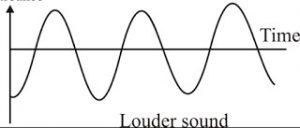

The loudness of the sound depends on the amplitude of the vibrations The pitch of the sound is the frequency of the vibrations. For all waves: wave speed = frequency × wavelength (v = f λ where f is in Hz, λ is in m, v is in m/s).Įxample: Water waves with wavelength λ = 10 cm and frequency f = 4 Hz have a speed v = 10 cm × 4 Hz= 40 cm/s. The wave equation relates the wavelength and frequency to the wave speed. In 4 s it travels d = 5 cm/s × 4 s = 20 cm. Wave speed depends on the medium that the wave is travelling through:ĭistance wave travels = wave speed × time (d = v × t )Įxample: A water wave travels at 5 cm/s. The frequency = 4 Hz.Įxample: A wave takes two seconds to pass a point. Theįrequency is usually expressed in hertz (Hz) where one Hz is one cycle (wave) per second.Įxample: Four waves pass a point in one second. This depends on how fast the source of the waves is vibrating. Wavelength (λ) is the distance in metres from any point on the wave to an exactly similar point.įrequency is the number of waves that pass a point in one second.

S-waves are transverse waves that can only travel through solid materials in the Earth.Īmplitude is the maximum displacement (change in position) from the undisturbed position. Its energy peaks at the wavelength determined by its temperature.P-waves are longitudinal waves that travel through solid or liquid rock.There are two types of seismic waves called P-waves and S-waves: It has compressions and between these are stretched parts called rarefactions.Įxamples include sound waves, ultrasound waves, which are sound waves with frequency greater than 20 kHz, and waves along a spring The wave has crests and troughs.Įxamples include water waves, waves on strings or rope, light and other electromagnetic waves.Ī longitudinal wave has vibrations parallel to the direction of wave travel. Waves transfer energy and information from one place to another, but they do not transfer material.Ī transverse wave has vibrations at right angles (perpendicular) to the direction of travel. This is called superposition.A wave is a vibration or disturbance transmitted through a material (a medium) or through space. When two differently directed waves (wavelets?) cross each other, then both contribute to what the medium does, but then travel on without change in their basic parameters of frequency, wavelength, or direction. When they encounter some non-uniformity in the medium, part of the wave can be redirected (refracted and/or reflected) and travel in a different direction. The important idea is that waves initially travel away from an initial disturbance. Standing waves, such as those formed on guitar strings, are the result of waves travelling in both directions. It is the height of the crest or depth of a trough measured from the normal undisturbed position. The AMPLITUDE is the maximum displacement from the rest position. Real waves can be described as superpositions of pure sinusoidal waves based on something known as the Fourier Theorem. Waves travel through a medium The high points of waves are called CRESTS or PEAKS while the low points are called TROUGHS. Or, you could turn the screen upside down :). Simply changing the sign of the $x$ term will reverse the direction of the wave. In the pictures you have, left and right are interchangeable because the pictures are generated using a mathematical formula similar to $$y=A\sin \left,$$ where $f$ is the periodic frequency and $\lambda$ is the wavelength. You can also see that, in your example, since every particle is moving up and down in harmonic motion, it doesn't really matters if you start by moving them up or down, and it wouldn't change the direction of energy flow. In water waves (for example the one you see after throwing a pebble in a lake), the energy moves from the pebble outwards, forming circles. If you held the rope at its center and shook it, energy (and thus the wave) would propagate in both directions. The energy flow is from its source (in my example, you shaking the rope) through the medium - the rope (in every possible direction). The unit for velocity would be the normal meters/second. We could measure a velocity for the wave if we measure how far horizontally a crest travels in a unit of time.

You starts shaking the rope, and then energy start flowing from you to the other end of the rope as you can guess, it is not really a matter of left to right or vice-versa. The distance from the maximum height of a crest to the undisturbed position is called the amplitude of the wave.

Imagine holding a rope at one end, which is fixed at the other end to some mechanism that can measure energy transported by the wave on the rope. It is really just a matter of where the motion comes from.


 0 kommentar(er)
0 kommentar(er)
